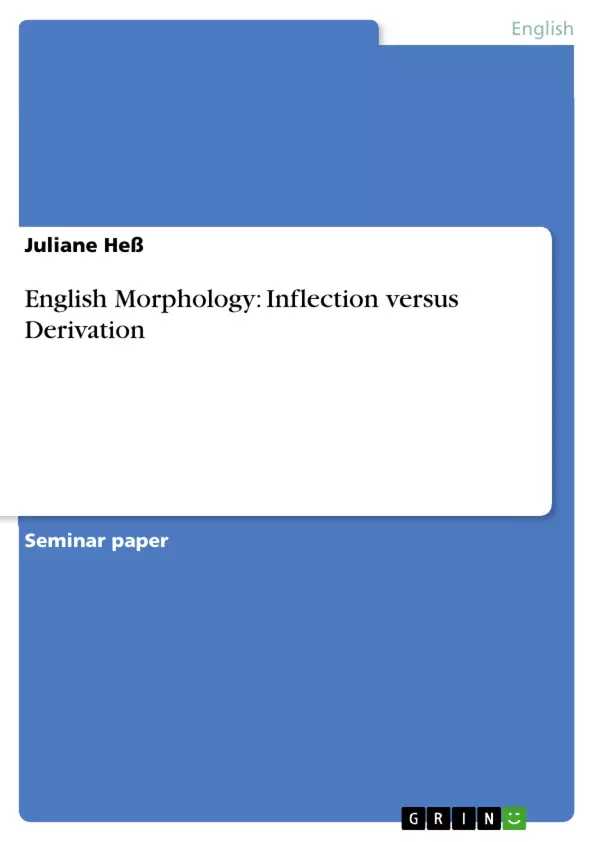What is morphology? An easy answer would be: “It is a field of linguistics!” But it is far more complex then this reply reveals. The field of morphology studies and analyses the form of words by factorizing them into morphemes. These morphemes are the smallest units the word can be divided in. But what is the smallest unit of a word? This could also be a letter. There is one word missing, which makes the definition complete, namely ‘meaning’. A proper definition of the term can be found in the OALD: “Morpheme: the smallest unit of meaning that a word can be divided into (827).” Words and morphemes are linguistic signs but even though the morpheme is considered a meaningful unit does not mean that every morpheme can be a word...
Table of Contents
- Introduction to Morphology
- Inflection
- What is Inflectional Morphology?
- Grammatical Categories
- The Inflected Word Classes
- Nouns and Verbs
- Adjectives and Numerals
- Irregularities of Inflection
- Suppletition and Portmanteau Morphemes
- Zero-Allomorphs and Vowel Change
- Derivation
- What is Derivation?
- Derivation via Affixation
- Derivation without Affixation
- Inflection versus Derivation
- Distinctions
- Stem versus Base
- Change of the Lexical Meaning
- Syntactical versus Lexical Function
- "Listedness"
- The Position of Derivational and Inflectional Affixes
- The Number of Affixes, Limitations and Frequency
- Similarities
- Roots
- Suffixes
- Irregularities
- Inherent and Contextual Inflection versus Derivation
Objectives and Key Themes
The main objective of this paper is to analyze and compare the processes of inflection and derivation in English morphology. It aims to highlight the key differences and similarities between these two fundamental word-building processes. The paper focuses on the following key themes:- Inflectional Morphology
- Derivational Morphology
- Distinction between Inflection and Derivation
- Grammatical Categories and Lexical Meaning
- Regular and Irregular Forms of Inflection and Derivation
Chapter Summaries
This preview will not include any content from the conclusion or final chapter. The following summarizes the main themes and arguments of the preceding chapters:
Introduction to Morphology introduces the field of morphology, focusing on the concept of morphemes as the smallest meaningful units of words. It explains the difference between free and bound morphemes, providing examples and a classification table. The chapter also introduces the distinction between lexical and grammatical morphemes, which is crucial for understanding the different roles of inflection and derivation.
Inflection defines inflectional morphology as a word-building process that focuses on grammatical context and changes in word shape determined by that context. The chapter explores different types of inflection, including inherent and contextual morphology, and provides examples for both. It also touches upon the distinction between regular and irregular forms of inflection and the importance of considering word class.
Derivation introduces the concept of derivational morphology as a word-building process that changes the lexical category of words and often adds new meanings. The chapter explores different methods of derivation, including affixation and conversion, and provides examples to illustrate the different processes.
Inflection versus Derivation delves into the key distinctions between these two processes, comparing their effects on word shape, lexical meaning, and grammatical function. This chapter examines the concepts of stem and base, "listedness", and the position of affixes.
Similarities highlights the shared characteristics of inflection and derivation, such as their reliance on roots and suffixes, the presence of irregularities, and the potential for contextual and inherent forms.
Keywords
This paper focuses on the study of English morphology, specifically examining the concepts of inflection and derivation. It explores key terms such as morphemes, free and bound morphemes, lexical and grammatical morphemes, regular and irregular forms, inherent and contextual morphology, stem, base, and "listedness". The paper delves into the grammatical functions of these processes and their influence on the lexical meaning of words.- Quote paper
- Juliane Heß (Author), 2009, English Morphology: Inflection versus Derivation, Munich, GRIN Verlag, https://www.grin.com/document/177586



